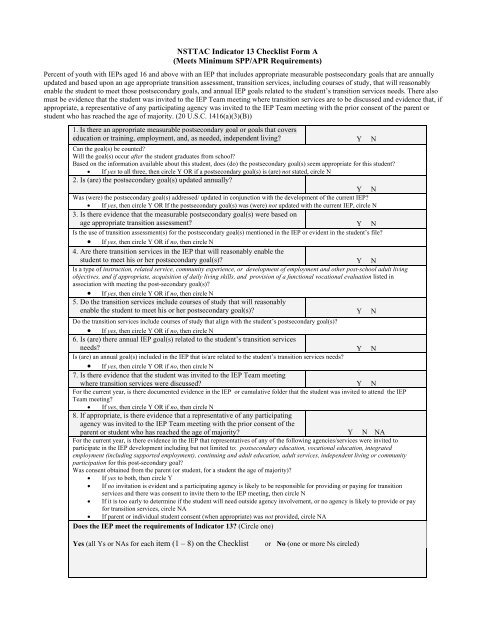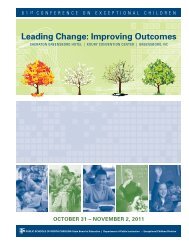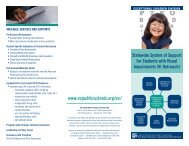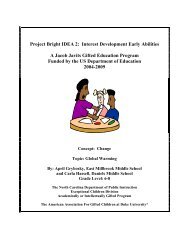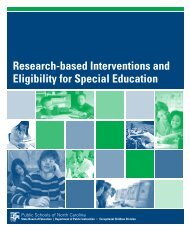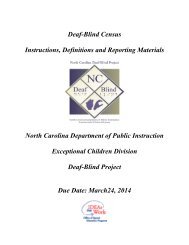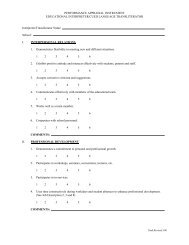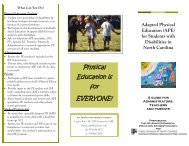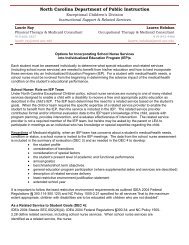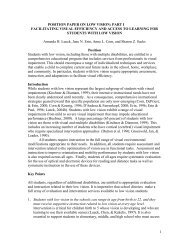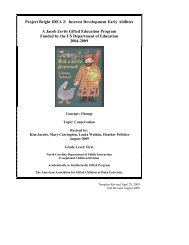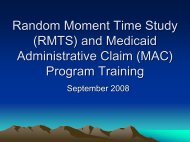NSTTAC Indicator 13 Checklist Form A (Meets Minimum SPP/APR ...
NSTTAC Indicator 13 Checklist Form A (Meets Minimum SPP/APR ...
NSTTAC Indicator 13 Checklist Form A (Meets Minimum SPP/APR ...
You also want an ePaper? Increase the reach of your titles
YUMPU automatically turns print PDFs into web optimized ePapers that Google loves.
<strong>NSTTAC</strong> <strong>Indicator</strong> <strong>13</strong> <strong>Checklist</strong> <strong>Form</strong> A<br />
(<strong>Meets</strong> <strong>Minimum</strong> <strong>SPP</strong>/<strong>APR</strong> Requirements)<br />
Percent of youth with IEPs aged 16 and above with an IEP that includes appropriate measurable postsecondary goals that are annually<br />
updated and based upon an age appropriate transition assessment, transition services, including courses of study, that will reasonably<br />
enable the student to meet those postsecondary goals, and annual IEP goals related to the student’s transition services needs. There also<br />
must be evidence that the student was invited to the IEP Team meeting where transition services are to be discussed and evidence that, if<br />
appropriate, a representative of any participating agency was invited to the IEP Team meeting with the prior consent of the parent or<br />
student who has reached the age of majority. (20 U.S.C. 1416(a)(3)(B))<br />
1. Is there an appropriate measurable postsecondary goal or goals that covers<br />
education or training, employment, and, as needed, independent living Y N<br />
Can the goal(s) be counted<br />
Will the goal(s) occur after the student graduates from school<br />
Based on the information available about this student, does (do) the postsecondary goal(s) seem appropriate for this student<br />
• If yes to all three, then circle Y OR if a postsecondary goal(s) is (are) not stated, circle N<br />
2. Is (are) the postsecondary goal(s) updated annually<br />
Y N<br />
Was (were) the postsecondary goal(s) addressed/ updated in conjunction with the development of the current IEP<br />
• If yes, then circle Y OR If the postsecondary goal(s) was (were) not updated with the current IEP, circle N<br />
3. Is there evidence that the measurable postsecondary goal(s) were based on<br />
age appropriate transition assessment Y N<br />
Is the use of transition assessment(s) for the postsecondary goal(s) mentioned in the IEP or evident in the student’s file<br />
• If yes, then circle Y OR if no, then circle N<br />
4. Are there transition services in the IEP that will reasonably enable the<br />
student to meet his or her postsecondary goal(s) Y N<br />
Is a type of instruction, related service, community experience, or development of employment and other post-school adult living<br />
objectives, and if appropriate, acquisition of daily living skills, and provision of a functional vocational evaluation listed in<br />
association with meeting the post-secondary goal(s)<br />
• If yes, then circle Y OR if no, then circle N<br />
5. Do the transition services include courses of study that will reasonably<br />
enable the student to meet his or her postsecondary goal(s) Y N<br />
Do the transition services include courses of study that align with the student’s postsecondary goal(s)<br />
• If yes, then circle Y OR if no, then circle N<br />
6. Is (are) there annual IEP goal(s) related to the student’s transition services<br />
needs Y N<br />
Is (are) an annual goal(s) included in the IEP that is/are related to the student’s transition services needs<br />
• If yes, then circle Y OR if no, then circle N<br />
7. Is there evidence that the student was invited to the IEP Team meeting<br />
where transition services were discussed Y N<br />
For the current year, is there documented evidence in the IEP or cumulative folder that the student was invited to attend the IEP<br />
Team meeting<br />
• If yes, then circle Y OR if no, then circle N<br />
8. If appropriate, is there evidence that a representative of any participating<br />
agency was invited to the IEP Team meeting with the prior consent of the<br />
parent or student who has reached the age of majority Y N NA<br />
For the current year, is there evidence in the IEP that representatives of any of the following agencies/services were invited to<br />
participate in the IEP development including but not limited to: postsecondary education, vocational education, integrated<br />
employment (including supported employment), continuing and adult education, adult services, independent living or community<br />
participation for this post-secondary goal<br />
Was consent obtained from the parent (or student, for a student the age of majority)<br />
• If yes to both, then circle Y<br />
• If no invitation is evident and a participating agency is likely to be responsible for providing or paying for transition<br />
services and there was consent to invite them to the IEP meeting, then circle N<br />
• If it is too early to determine if the student will need outside agency involvement, or no agency is likely to provide or pay<br />
for transition services, circle NA<br />
• If parent or individual student consent (when appropriate) was not provided, circle NA<br />
Does the IEP meet the requirements of <strong>Indicator</strong> <strong>13</strong> (Circle one)<br />
Yes (all Ys or NAs for each item (1 – 8) on the <strong>Checklist</strong><br />
or No (one or more Ns circled)
2<br />
Instructions for Completing <strong>NSTTAC</strong> <strong>Indicator</strong> <strong>13</strong> <strong>Checklist</strong><br />
1. Is there an appropriate measurable postsecondary goal or goals that covers education or<br />
training, employment, and, as needed, independent living<br />
• Find the postsecondary goal(s) for this student<br />
• If there are appropriate measurable postsecondary goals that address Education or Training<br />
after high school, Employment after high school, and (if applicable) Independent Living after<br />
high school and if the identified postsecondary goal(s) in Education or Training,<br />
Employment, and (if applicable) Independent Living appear to be appropriate for the student,<br />
based on the other information regarding Present Level of Academic and Functional<br />
Performance and / or the student’s strengths, preferences, and interests, circle Y<br />
• If there are postsecondary goals that address Education or Training after high school,<br />
Employment after high school, and (if applicable) Independent Living after high school, but<br />
are not measurable, circle N<br />
• If there is misalignment between the student’s postsecondary goal(s), based on the<br />
information available (e.g., present level of performance, student interests, student<br />
preferences), circle N<br />
• If there is not a postsecondary goal that addresses Education or Training after high school,<br />
circle N<br />
• If there is not a postsecondary goal that addresses Employment after high school, circle N<br />
• If there is one postsecondary goal that addresses Education or Training, Employment, and (if<br />
applicable) Independent Living after high school, but it is not measurable, circle N<br />
2. Is the postsecondary goal(s) updated annually<br />
• If the postsecondary goal(s) for Education or Training, Employment, and as needed<br />
Independent Living, is (are) documented in the student’s current IEP, circle Y<br />
• If the postsecondary goal(s) for Education or Training, Employment, and as needed<br />
Independent Living, is (are) not documented in the student’s current IEP, circle N<br />
• If this is the student’s first IEP that addresses secondary transition services because they just<br />
turned 16, this is considered an update, so circle Y<br />
3. Is there evidence that the measurable postsecondary goals were based on age appropriate<br />
transition assessment<br />
• Find where information relates to assessment and the transition component on the IEP (either<br />
in the IEP or the student’s file)<br />
• For each postsecondary goal, if there is evidence that at least one age appropriate transition<br />
assessment was used to provide information on the student's needs, strengths, preferences, and<br />
interests regarding the postsecondary goal(s), circle Y<br />
• For each postsecondary goal, if there is no evidence that age appropriate transition assessment<br />
provided information on the student’s needs, taking into account strengths, preferences, and<br />
interests regarding the postsecondary goal(s), circle N<br />
• If a postsecondary goal area was addressed in item #1, but was not measurable and if there is<br />
age appropriate transition assessment information, from one or more sources, provided<br />
regarding the student’s needs, taking into account strengths, preferences, and interests<br />
regarding this postsecondary goal, circle Y<br />
• If a postsecondary goal area was addressed in item #1, but was not measurable and if there is<br />
not age appropriate transition assessment information provided on the student’s needs, taking<br />
into account strengths, preferences, and interests regarding this postsecondary goal, circle N<br />
4. Are there transition services in the IEP that will reasonably enable the student to meet his or her<br />
postsecondary goal(s)<br />
______________________________________________________________________________________<br />
Prepared by the National Secondary Transition Technical Assistance Center (<strong>NSTTAC</strong>)<br />
September, 2006; updated July, 2009
• Find where transition services/activities are listed on the IEP<br />
• For each postsecondary goal, if there is a type of instruction, related service, community<br />
experience, or development of employment and other post-school adult living objectives, and<br />
if appropriate, acquisition of daily living skill(s), and provision of a functional vocational<br />
evaluation listed in association with meeting the postsecondary goal, circle Y<br />
• For each postsecondary goal, if there is no (a) type of instruction, (b) related service, (c)<br />
community experience, (d) development of employment and other post-school adult living<br />
objective, (e) if appropriate, acquisition of a daily living skill, or (f) if appropriate, provision<br />
of a functional vocational evaluation listed in association with meeting the postsecondary<br />
goal, circle N<br />
• If a postsecondary goal area was addressed in item #1, but was not measurable and there is a<br />
type of transition services listed in association with meeting that postsecondary goal, circle Y<br />
• If a postsecondary goal area was addressed in item #1, but was not measurable and there is no<br />
type of transition service listed in association with meeting that postsecondary goal, circle N<br />
5. Do the transition services include courses of study that will reasonably enable the student to meet<br />
his or her postsecondary goal(s)<br />
• Locate the course of study (instructional program of study) or list of courses of study in the<br />
student’s IEP<br />
• Are the courses of study a multi-year description of coursework from the student’s current to<br />
anticipated exit year that is designed to help achieve the student’s desired post-school goal(s)<br />
If yes, go to next instruction bullet. If no, circle N<br />
• Do the courses of study align with the student’s identified postsecondary goal(s) If yes,<br />
circle Y. If no, circle N<br />
6. Is (are) there annual IEP goal(s) that are related to the student’s transition services needs<br />
• Find the annual goals, or, for students working toward alternative achievement standards, or<br />
States in which short-term objectives are included in the IEP, short-term objectives on the IEP<br />
• For each of the postsecondary goal areas circled Y in question #1, if there is an annual goal or<br />
short-term objective included in the IEP related to the student’s transition services needs,<br />
circle Y<br />
• For each of the postsecondary goal areas circled Y in question #1, if there is no annual goal or<br />
short-term objective included in the IEP related to the student’s transition services needs,<br />
circle N<br />
• If a postsecondary goal area was addressed in #1, but was not measurable, and an annual goal<br />
is included in the IEP related to the student’s transition services needs, circle Y<br />
• If a postsecondary goal area was addressed in #1, but was not measurable, and there is no<br />
annual goal included the IEP related to the student’s transition services needs, circle N<br />
7. Is there evidence that the student was invited to the IEP Team meeting where transition services<br />
were discussed<br />
• Locate the documentation of the invitation to the IEP conference for the student.<br />
• Was the student invitation signed (by the LEA) and dated prior to the date of the IEP<br />
conference. If yes, circle Y. If no, circle N<br />
8. If appropriate, is there evidence that a representative of any participating agency was invited to<br />
the IEP Team meeting with the prior consent of the parent or student who has reached the age of<br />
majority<br />
• Find where persons responsible and/or agencies are listed on the IEP<br />
• Are there transition services listed on the IEP that are likely to be provided or paid for by an<br />
outside agency If yes, continue with next instruction bullet. If no, circle NA.<br />
3<br />
______________________________________________________________________________________<br />
Prepared by the National Secondary Transition Technical Assistance Center (<strong>NSTTAC</strong>)<br />
September, 2006; updated July, 2009
• Was parent consent or student consent (once student has reached the age of majority) to invite<br />
an outside agency(ies) obtained If yes, continue with next instruction bullet. If no, circle N<br />
• If a postsecondary goal area was addressed in item #1, but was not measurable and there is<br />
evidence that agency(ies) for which parent/student had given their consent to invite, were<br />
invited to the IEP meeting to discuss transition, circle Y<br />
• If a postsecondary goal area was addressed in item #1, but was not measurable and there is no<br />
evidence that agency(ies) for which parent/student had given their consent to invite, were<br />
invited to the IEP meeting to discuss transition, circle N<br />
• If it is too early to determine if this student will need outside agency involvement, circle NA<br />
Does the IEP meet the requirements of <strong>Indicator</strong> <strong>13</strong><br />
• If all Ys or NAs for each item (1 – 8) on the <strong>Checklist</strong>, then circle Yes<br />
• If one or more Ns are circled, then circle No<br />
4<br />
______________________________________________________________________________________<br />
Prepared by the National Secondary Transition Technical Assistance Center (<strong>NSTTAC</strong>)<br />
September, 2006; updated July, 2009


